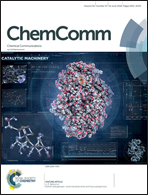[FeFe]-Hydrogenases: recent developments and future perspectives
Abstract
[FeFe]-Hydrogenases are the most efficient enzymes for catalytic hydrogen turnover. Their H2 production efficiency is hitherto unrivalled. However, functional details of the catalytic machinery and possible modes of application are discussed controversially. The incorporation of synthetically modified cofactors and utilization of semi-artificial enzymes only recently allowed us to shed light on key steps of the catalytic cycle. Herein, we summarize the essential findings regarding the redox chemistry of [FeFe]-hydrogenases and discuss their catalytic hydrogen turnover. We furthermore will give an outlook on potential research activities and exploit the utilization of synthetic cofactor mimics.
![Graphical abstract: [FeFe]-Hydrogenases: recent developments and future perspectives](/en/Image/Get?imageInfo.ImageType=GA&imageInfo.ImageIdentifier.ManuscriptID=C8CC01275J&imageInfo.ImageIdentifier.Year=2018)


 Please wait while we load your content...
Please wait while we load your content...